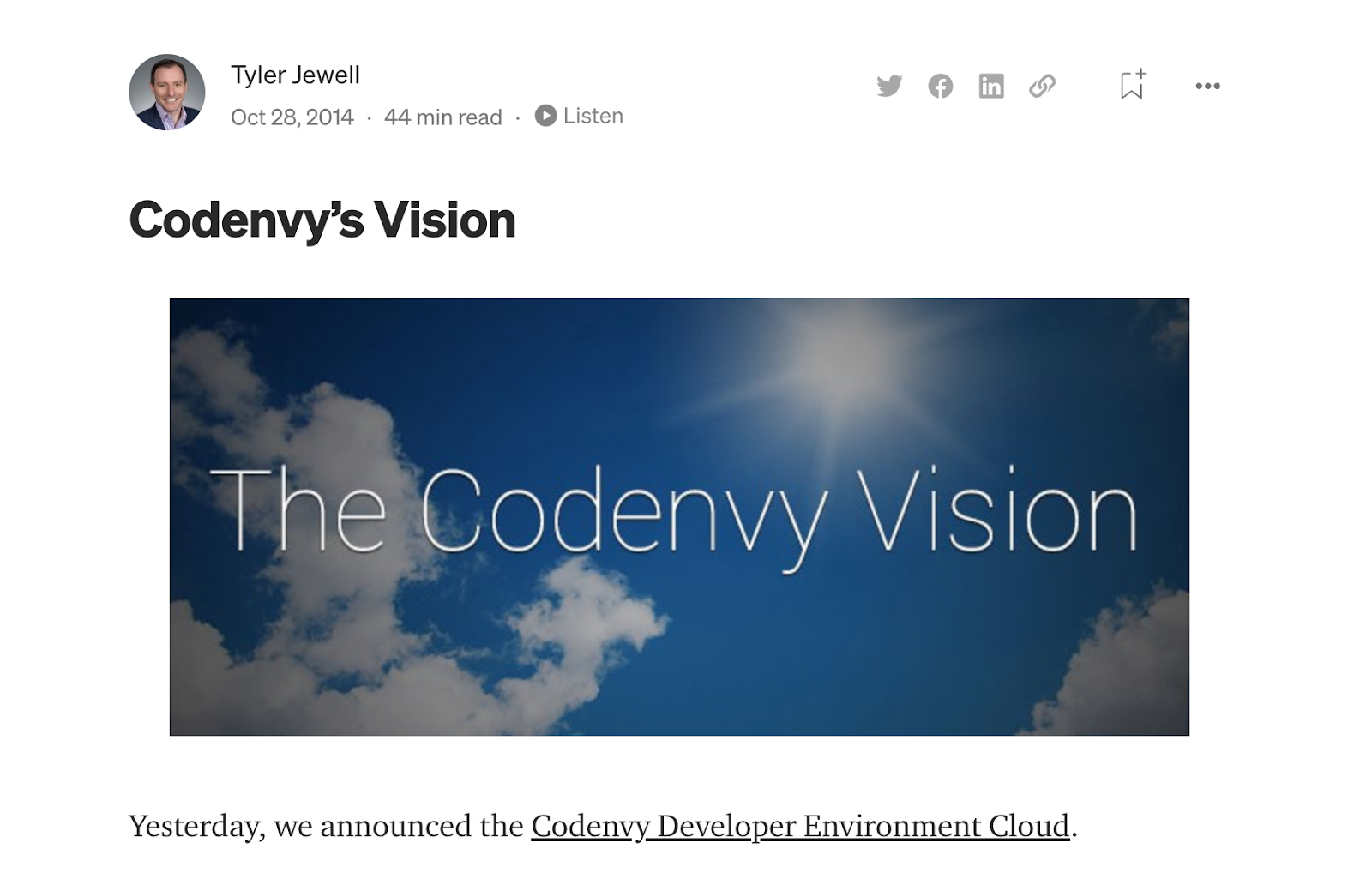Thought Leadership for Technical Founders
Thought Leadership for Technical Founders
Before starting Draft.dev, I led engineering teams at a couple of technology startups in Chicago. One of my most important responsibilities was attracting and hiring technical talent. Because I had enjoyed writing since college, I decided that I would leverage that skill as an asset for recruiting.
In job descriptions, I would share several pieces I had written, and in almost every interview, candidates would tell me that they loved reading these posts about our hiring process, engineering culture, and technical choices. This content built trust and credibility with candidates, allowing them to get to know me as a leader before we ever sat down for an interview.
In this article, I’d like to share with founders the who, what, why, and how of creating thought leadership content, which can build credibility, humanize your company, and engage technical prospects with one of their favorite topics: solving complex problems in creative ways.
Words matter. At a minimum, they shape the impression you make on others — often the first impression...writing ranks as perhaps the highest-leveraged tool available to leaders of all stripes.
- David Girouard, CEO at Upstart
For companies building software tools for developers, content that builds technical thought leadership is even more valuable. It comes into play whether you’re fundraising, hiring top-level talent, or trying to convince your first customers to put down their credit cards. Great writing can also attract press coverage and social media attention better than keyword-driven writing while requiring a much smaller volume of content.
That said, long-form writing is hard. It takes a lot of time to do well, and most technical founders would rather work on their product than write blog posts.
In this piece, I’ll offer some frameworks and tips that will make producing technical thought leadership easier. I’ll share some of the more common varieties (writing is much easier when you have a template) and a few habits that will help you produce highly-credible content more quickly.
Thought Leadership Frameworks
The term “thought leadership” is often misused, so let me first clarify what I mean.
True “thought leadership” is opinionated, personal, and originates from a deep knowledge of a topic or industry. Sometimes marketers use the term to indicate any high-level piece of content, but I’d argue that effective thought leadership must share a point of view based on a unique personal experience.
In order for content to rise to the level of thought leadership, it has to be authentic. It has to be deeply rooted in your unique perspective or experience or expertise.
- Katie Parrott, Content Strategist at Animalz
So, when you look at technical thought leadership content, you’ll see a few common patterns:
1. Why and How We Built This
These posts are often among the first pieces of content a developer-first company should produce. In them, technical leaders (usually a founder or founding engineer) will explain the personal backstory or problem statement that led to the creation of their company and the technical path to their solution. This kind of content humanizes the business and helps build confidence that the team understands the problem and solution space very well.
Walking through the problem, and your approach to the solution, can also connect the dots between the challenges your prospects face and the solutions you provide. You’re giving them a chance to get to know you better, but also giving them a glimpse of how they, too, can “come out on the other side” with a solution to their challenges as well.
Examples:
- Codenvy’s Vision by Tyler Jewel
- How we built a VS Code extension with Rust, WebAssembly, and TypeScript

2. Forecasting the Future
The next pattern you see is some version of predicting the future, spotting an emerging trend, or pointing out a problem on the rise. This content is typically written by founders to illustrate their insight into where the industry or category is heading (and presumably, why their solution is designed for that future). In addition to being interesting to engineers in the field, this kind of content is also attractive to investors who want to see founders with a clear vision.
Examples:
- The Modern Data Experience by Benn Stancil
- Absolute Scale Corrupts Absolutely by Avery Pennarun (Tailscale)

3. Taking a Stand
Another way to exhibit thought leadership is by making a persuasive argument against a commonly held belief. In this pattern, the author typically shares a unique perspective they have and why it’s led them to change accepted behaviors. These are often controversial, but that’s the point. While you don’t want to turn people off by being inflammatory for the sake of it, many startups benefit from polarizing people.
Examples:

4. TIL (Today I Learned) Journey
Finally, you can share something (or many things) you learned recently. Often these pieces explore a mistake or misunderstanding, the journey you went on to find a solution, and the lessons you learned along the way. This kind of writing shows vulnerability, humility, and growth, which help humanize your brand. These are especially interesting to senior-level engineers who generally love seeing deep technical knowledge and novel solutions to complex problems.
Examples:
- 42 Things I Learned from Building a Production Database
- How I Learned to Stop Worrying and Love the State Machine
While there are plenty of other ways to write thought leadership content and make your own variations on these patterns, starting with a framework makes organizing and laying out my ideas much easier. So, if you’re stuck getting started, use an established pattern for your content and apply one of these frameworks to your domain of expertise.

Writing Better Thought Leadership Content
Beyond using an established framework, there are many things you can do to get better at technical thought leadership. A lot of people assume that writing is all about perfecting your English grammar, but there are more-fundamental skills to figure out first (Grammarly can probably take care of most of the other stuff anyway).
1. Focus on a Few Topics You Know Really Well
Many of the most popular people on the internet simply remix information. When this happens, everybody wins: Readers get to learn, you get website traffic, and authors get more visibility. Take existing ideas and remix them in productive ways.
- David Perell, How to Write More
If you’re new to writing, focus on two to three topic areas that you know really well and write several different variations on each theme. By focusing on the same ideas repeatedly, you’ll start to clarify your vision and get markedly better at getting your point across. Don’t worry about originality because as you write more, you’ll start to put your unique spin on these topics.
The great thing about writing is that you can do it on many different platforms to get different versions of the same topic in front of new audiences. For example, you can write a long-form piece for your company’s blog, a thread for Twitter, a mid-length summary for Linkedin, another version as a guest post for DZone, the list goes on. (Some external blogs and media outlets may check for plagiarism to avoid having their website penalized by Google’s algorithm, so light re-writes might be necessary from time to time.) Experiment with changing up the language slightly for each channel to see what performs well, and avoid cannibalizing your own content.
2. Support a Single Thesis
Written arguments often fail when they employ ranting rather than reasoning.
- Tara Horkoff, Writing for Success
One of the easiest ways to stay on topic when you write something is to continue revisiting and refining a single thesis or core idea. Try to cut any content that doesn’t directly support that thesis so that you make your point clear and avoid distracting readers. Build your argument throughout the piece and then re-emphasize the point again at the end.
3. Organize Before Writing
One of the biggest barriers new writers face is the blank page. Without a guide, it’s easy to let your piece turn into a random rambling of ideas and get frustrated when it doesn’t come together.
The simple solution is to start with an outline. Once you have that, you can start to fill in details, look for sources to support your points, and decide on reasonable breaking points between ideas.
4. Make it Personal but Use Evidence
While thought leadership writing should be personal, supplementing your personal experiences with data, quotes, and linked sources will help your work seem less subjective and help you build credibility. Providing data points from well-known sources (such as from published research or credible, well-known media outlets) to back up what you say not only strengthens your point, but can also serve as a form of buyer enablement. Not everyone who reads your content may have the ability to approve budgets. So, building credible, data-supported content may eventually help your readers write a business case to their boss one day.
You can break up long stretches of conjecture with stories, examples, and supporting evidence to add authority and variety to your writing. Great writers know how to give a reader context, allowing them to establish their own opinions while building appreciation for yours.
5. Figure Out How to Make Time for Writing
Finally, if you want to get better at writing in general, you have to make time for it. Some people like building a daily writing habit, blocking time on their calendar, or pairing up with a professional ghostwriter. No matter how you go about it, you will get better at writing the more you do it, so find a system that works for you within the time constraints you have.
Ultimately, getting your perspective in front of the world is one of the highest leverage things a founder can do, but it does take a commitment.
Summary
Technical startup leaders can get a lot of value out of even just a few strong pieces of thought leadership content. Building credibility with employees, investors, and customers is a force multiplier for your business when you recognize that it’s a time and energy investment worth making.
I hope some of the tips and frameworks in this piece will help you as you get started, but I’m also happy to answer questions and offer individual tips. You can find me on Twitter or at karl@draft.dev.
Subscribe to Heavybit Updates
You don’t have to build on your own. We help you stay ahead with the hottest resources, latest product updates, and top job opportunities from the community. Don’t miss out—subscribe now.
Content from the Library
Generationship Ep. #25, Replacing Yourself featuring Melinda Byerley
In episode 25 of Generationship, Rachel Chalmers speaks with Melinda Byerley, founder and CEO of Fiddlehead, about the...
Open Source Ready Ep. #2, Defining Open Source with Avi Press of Scarf
In episode 2 of Open Source Ready, Brian Douglas and John McBride speak with Avi Press, Founder & CEO of Scarf. Together they...
How It's Tested Ep. #12, Mobile Deep Linking with Daniel Johnson of Branch
In episode 12 of How It’s Tested, Eden Full Goh is joined by Daniel Johnson of Branch to explore the complexities of mobile deep...
